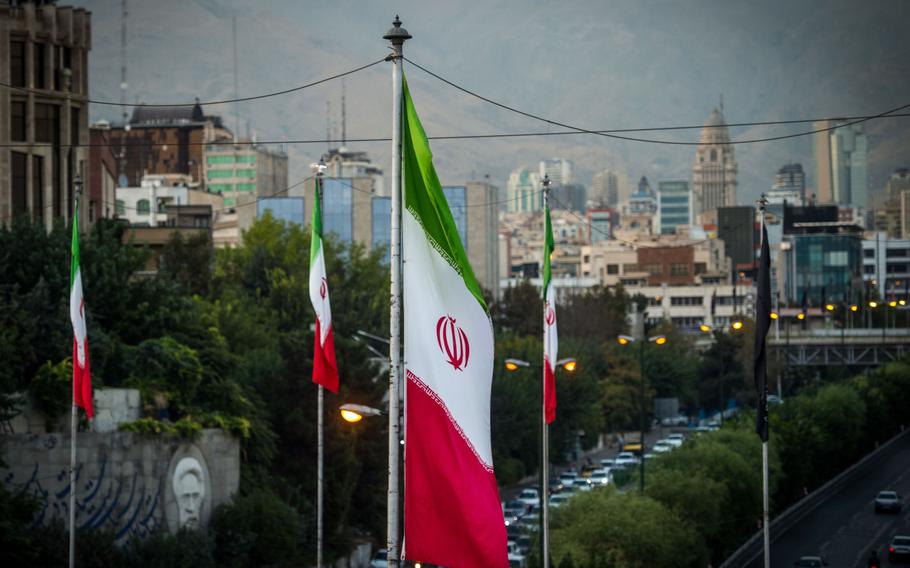
Iranian national flags fly near a major highway through Tehran, Iran, on Tuesday, Sept. 17. 2019. Iranian Foreign Minister Mohammad Javad Zarif refused to rule out military conflict in the Middle East after the U.S. sent more troops and weapons to Saudi Arabia in response to an attack on oil fields the U.S. has blamed on the Islamic Republic. (Ali Mohammadi/Bloomberg)
Iran increased its stockpile of uranium enriched just below the level needed for nuclear weapons, potentially compounding Middle East tensions already heightened by the Israel-Hamas war.
Nuclear inspectors from the United Nations watchdog told diplomats Wednesday that Iran’s stockpile of highly-enriched uranium gained 5% since September, compared with a 7% increase the previous quarter. The rise follows a U.S. decision to re-freeze $6 billion of Iranian funds stranded in Qatar due to the risk Tehran was involved in the Oct. 7 Hamas attack against Israel, which triggered the ongoing conflict.
The International Atomic Energy Agency reiterated complaints that “monitoring has been seriously affected” by Iran’s decision to remove some of its surveillance equipment. “Iran has directly and seriously affected the agency’s ability to conduct its verification activities,” according to the 11-page restricted report seen by Bloomberg News. The IAEA document re-focuses attention on Iran’s nuclear work just as tensions flare across the Middle East amid Israel’s ground offensive in Gaza and tit-for-tat attacks between U.S. forces and Iranian-backed militias in other territories. Underscoring the seriousness, a resolution passed by the House of Representatives earlier this month declared the U.S. should use all means necessary to prevent the Persian Gulf nation from obtaining a nuclear weapon.
Iran began enriching uranium to 60% in retaliation for a 2021 attack on its largest nuclear-fuel plant in Natanz, which it blamed on Israel. While that purity is still below the 90% grade typically used for weapons, it’s much higher than the cap set by the now-defunct nuclear accord that Iran agreed with world powers in 2015. While the IAEA report showed Iran reducing enrichment rates — accumulation of 60% fuel has dropped to about 3 kilograms a month from 9 kilograms in the second quarter — other frictions cropped up.
The IAEA printed a portion of a letter it received Wednesday from Iran’s top atomic official, Mohammad Eslami, that dismissed inspector requests as “not compelling” and lacking “any legal basis.” Iran’s continued enrichment and lack of cooperation with IAEA monitors casts a shadow on months of diplomacy with the U.S., which had seen the Islamic Republic begin to roll back highly-enriched uranium production in September. The shift followed months of secret talks between Tehran and Washington that led to an understanding that American prisoners held by Iran would be freed in return for the release of billions of dollars of U.S.-frozen Iranian funds.
U.S. officials have privately acknowledged that enforcement of sanctions on Iranian oil sales has been relaxed, allowing Tehran to ramp up production. With the world’s No. 4 oil reserves, Iran has been shipping the most crude to China in a decade. But Hamas’ Oct. 7 attack and subsequent Israeli retaliation in Gaza have undermined the tenuous detente, with the U.S. sending an attack submarine and aircraft carrier strike force into the region. On Sunday, President Joe Biden authorized U.S. attacks on facilities in eastern Syria used by Iran’s Islamic Revolutionary Guard Corps, citing attacks by Iran-backed militias since the war began.
Iran’s stockpile of uranium enriched to 60% levels of purity rose to 128.3 kilograms (282.9 pounds) from 121.6 kilograms (268.1 pounds) in September, the IAEA inspectors concluded. Inventories of 20%-enriched fuel grew to 567.1 kilograms from 535.8 kilograms.